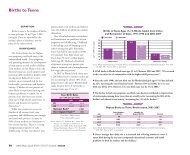2010 Rhode Island Kids Count Factbook
2010 Rhode Island Kids Count Factbook
2010 Rhode Island Kids Count Factbook
Create successful ePaper yourself
Turn your PDF publications into a flip-book with our unique Google optimized e-Paper software.
References<br />
16,21<br />
Chang, H. N. & Aguilar, Y. F. (2009). Why<br />
addressing attendance and chronic absence matters: A<br />
call to action for school board members and district<br />
superintendents. Retrieved March 5, <strong>2010</strong> from<br />
www.chronicabsence.net<br />
(continued from page 147)<br />
References for School Attendance<br />
6<br />
Railsback, J. (2004). Increasing student attendance:<br />
Strategies from research and practice. Portland, OR:<br />
Northwest Regional Educational Laboratory.<br />
7<br />
Wilkins, J. (2008). School characteristics that influence<br />
student attendance: Experiences of students in a school<br />
avoidance program. Chapel Hill, NC: The University<br />
of North Carolina Press.<br />
9,11,22,25<br />
On-line training developed by the Education<br />
Development Center, Inc. for the U.S. Department<br />
of Education. (n.d.). Truancy: A serious problem for<br />
students, schools, and society. Retrieved February 26,<br />
<strong>2010</strong> from www.ed.gov<br />
10,12<br />
Spencer, A. M. (2009). School attendance patterns,<br />
unmet educational needs, and truancy: A<br />
chronological perspective. Remedial and Special<br />
Education, 30(5), 309-319.<br />
13,28<br />
Sundius, J. & Farneth, M. (2008). Putting kids out of<br />
school: What’s causing high suspension rates and why<br />
they are detrimental to students, schools, and<br />
communities. Baltimore, MD: Open Society Institute.<br />
14,27<br />
Sundius, J. & Farneth, M. (2008). On the path to<br />
success: Policies and practices for getting every child to<br />
school every day. Baltimore, MD: Open Society<br />
Institute- Baltimore.<br />
16,17,19<br />
<strong>Rhode</strong> <strong>Island</strong> Department of Elementary and<br />
Secondary Education, 2008-2009 school year.<br />
18<br />
Westsat and EMT, Associates, Inc. (2007). The<br />
Uniform Data Set: A guide to measures for the uniform<br />
management information and reporting system.<br />
Washington, DC: U.S. Department of Education,<br />
Office of Safe and Drug-Free Schools.<br />
23<br />
Claes, E., Hooghe, M. & Reeskens, T. (2009). Truancy<br />
as a contextual and school- related problem. A<br />
comparative multilevel analysis of country and school<br />
characteristics on civic knowledge among 14 year<br />
olds. Educational Studies, 35(2), 123-142.<br />
24<br />
Sundius, J. & Farneth, M. (2008). An epidemic of<br />
absence: How can we get kids to school? Baltimore,<br />
MD: Open Society Institute.<br />
(continued from page 149)<br />
References for Suspensions<br />
3,5<br />
Sautner, B. (2001). Rethinking the effectiveness of<br />
suspensions. Reclaiming Children and Youth, 9(4),<br />
210-214.<br />
4,8,9,10,11,12,13<br />
<strong>Rhode</strong> <strong>Island</strong> Department of Elementary and<br />
Secondary Education, 2008-2009 school year.<br />
14<br />
Children’s Mental: Facts for Policymakers. (2006). New<br />
York, NY: National Center for Children in Poverty.<br />
7,15<br />
Sundus, J. & Farneth, M. (2008). Putting kids out of<br />
school: What’s causing high suspension rates and why<br />
they are detrimental to students, schools, and<br />
communities. Baltimore, MD: Open Society<br />
Institute.<br />
16<br />
Policy Statement: Out-of-School Suspension and<br />
Expulsion. (2003). Pediatrics, 112 (5), 1206-1209.<br />
(continued from page 151)<br />
References for High School Graduation Rate<br />
8,9,11<br />
<strong>Rhode</strong> <strong>Island</strong> Department of Elementary and<br />
Secondary Education, class of 2009 four-year cohort<br />
rates.<br />
10<br />
Almeida, C., Johnson, C. & Steinberg, A. (2006).<br />
Making good on a promise: What policymakers can do<br />
to support the educational persistence of dropouts.<br />
Boston, MA: Jobs for the Future.<br />
12<br />
When girls don’t graduate we all fail: A call to improve<br />
high school graduation rates for girls. (2007). New<br />
York, NY: National Women’s Law Center.<br />
(continued from page 153)<br />
References for College Preparation and Access<br />
3<br />
Engle, J. & Lynch, M. (2009). Charting a necessary<br />
path: The baseline report of public higher education<br />
systems in the access to success initiative. Washington,<br />
DC: The National Association of System Heads and<br />
the Education Trust.<br />
4,6<br />
Ready for College: Advocates Series Action Brief #1.<br />
(2006). Washington, DC: The Forum for Youth<br />
Investment.<br />
7,8<br />
Chait, R. & Venezia, A. (2009). Improving academic<br />
preparation for college: What we know and how state<br />
and federal policy can help. Washington, DC: Center<br />
for American Progress.<br />
9,12,14,17,19,20<br />
Roderick, M., et al. (2008). From high school to<br />
the future: Potholes on the road to college. Chicago, IL:<br />
Consortium on Chicago School Research, University<br />
of Chicago.<br />
10<br />
Haskins, R., Holzer, H. & Lerman, R. (2009).<br />
Promoting economic mobility by increasing<br />
postsecondary education. Washington, DC: The<br />
Economic Mobility Project.<br />
11<br />
Hoffman, N., Vargas, J. & Santos, J. (2008). On the<br />
ramp to college: A state policymaker’s guide to dual<br />
enrollment. Boston, MA: Jobs for the Future.<br />
13<br />
Nagaoka, J., Roderick, M. & Coca, V. (2009). Barriers<br />
to college attainment: Lessons from Chicago. Chicago,<br />
IL: The Consortium on Chicago School Research,<br />
University of Chicago and the Center for American<br />
Progress.<br />
15<br />
<strong>Rhode</strong> <strong>Island</strong> Department of Elementary and<br />
Secondary Education, 2008-2009 school year.<br />
16<br />
Felner, R. (2008). 2007-2008 student reports of<br />
academic expectations (high school SALT Survey).<br />
Rock <strong>Island</strong>, IL: National Center on Public<br />
Education and Prevention.<br />
18<br />
The 5th annual AP report to the nation. (2009). New<br />
York, NY: The College Board.<br />
(continued from page 155)<br />
(continued from page 155)<br />
References for<br />
Teens Not in School and Not Working<br />
13<br />
U.S. Census Bureau, American Community Survey,<br />
2008. Table S2301.<br />
14<br />
Kuehn, D., Pregamit, M., Macomber, J. & Vericker, T.<br />
(2009). Vulnerable youth and the transition to<br />
adulthood: Multiple pathways connecting to school and<br />
work. Office of the Assistant Secretary of Planning<br />
and Evaluation, Office of Human Services, U.S.<br />
Department of Health and Human Services.<br />
Washington, DC: Government Printing Offices.<br />
16<br />
Brinson, D., Hassel, B. & Rosch, J. (2008). Connecting<br />
youth through multiple pathways. Disconnected Youth<br />
and Multiple Pathways to Graduation. Chapel Hill,<br />
NC: Public Impact for the Annie E. Casey<br />
Foundation.<br />
17<br />
Early College High School Initiative. (n.d.). Overview<br />
& FAQ: What are early college high schools? Retrieved<br />
January 2, 2007 from<br />
www.earlycolleges.org/overview.html#basics1<br />
20,21<br />
<strong>Rhode</strong> <strong>Island</strong> Family Court, Intake Charges,<br />
1997-2008.<br />
172 <strong>2010</strong> <strong>Rhode</strong> <strong>Island</strong> KIDS COUNT <strong>Factbook</strong> / References






